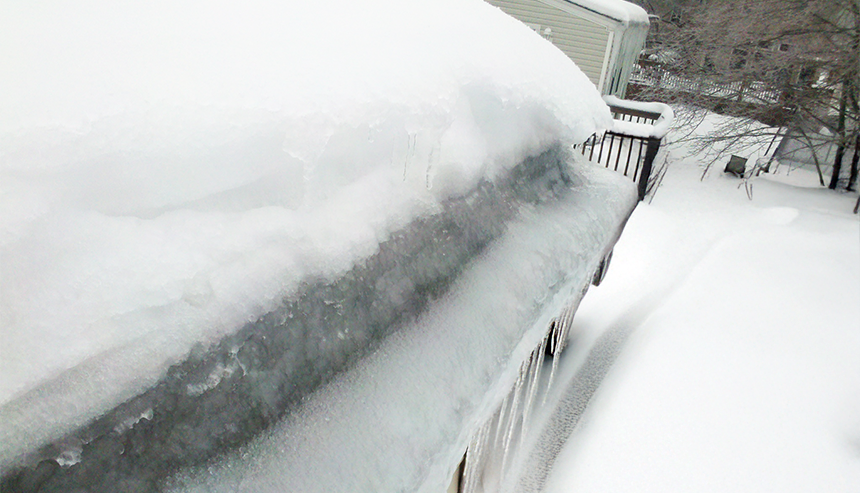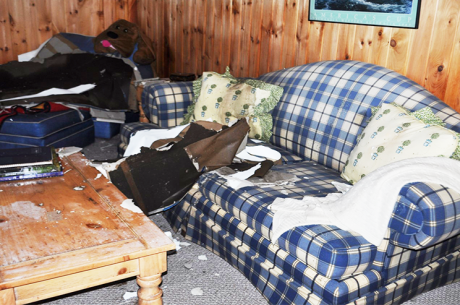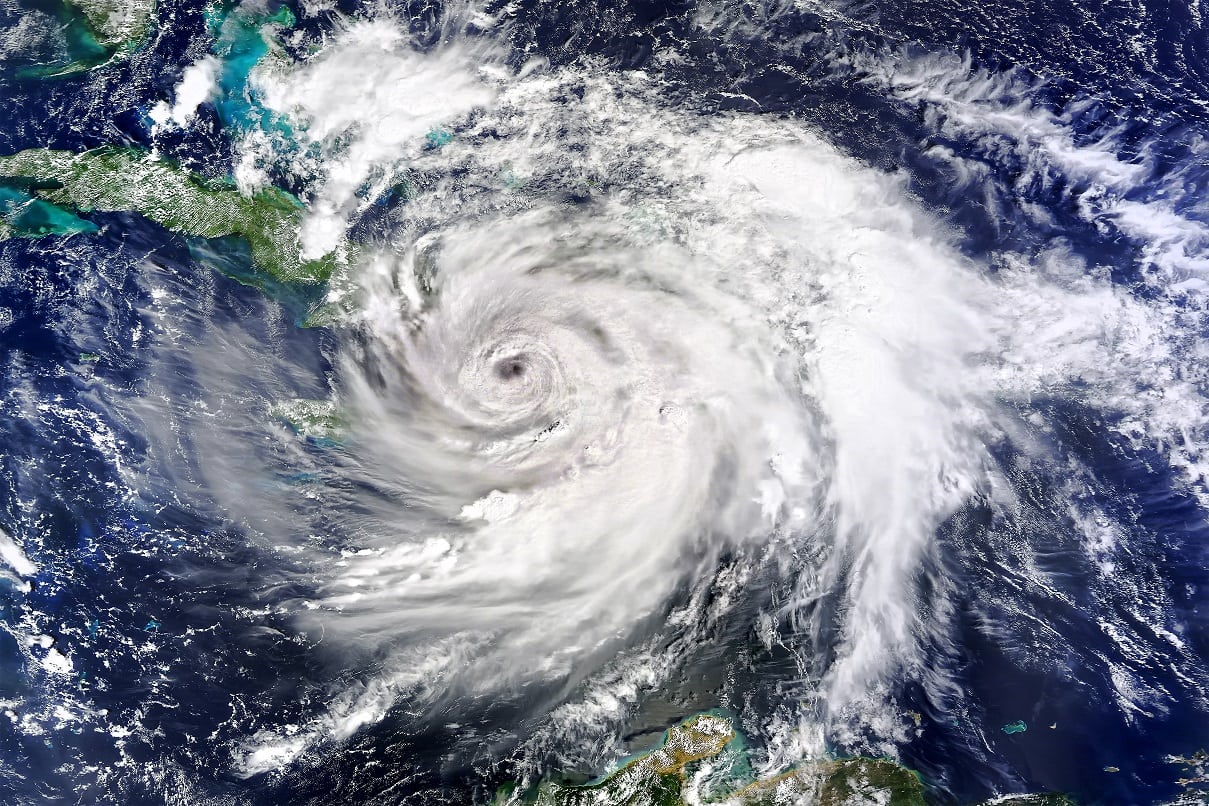Winter in Cranford, NJ, can be beautiful, but the freezing temperatures bring more than just picturesque snow-covered landscapes—they can also lead to severe home damage. One of the biggest winter threats? Ice dams.
These ridges of ice form along the edges of your roof, blocking proper drainage and forcing water into places it shouldn’t be. Unchecked ice dams can cause significant structural damage and costly water issues inside your home.
In this article, we’ll walk you through how to spot ice dams, how to prevent them before they cause trouble, and what to do if your home has already been affected.
Key Takeaways
- Ice dams form when melted snow freezes near the edge of a roof, potentially leading to water damage, mold growth, and structural issues.
- Preventive measures such as proper attic insulation and ensuring adequate ventilation reduce the risk of ice dam formation.
- To prevent expensive repairs, immediately address warning signs, like water stains on ceilings.
Understanding Ice Dam Damage
Ice dams are a common winter problem. They form when melted snow refreezes and “dams” the water behind it. This blockage prevents water from draining correctly. As snow melts and flows down the roof, it refreezes at the eaves, forming a growing ice dam.
The consequences can be severe. Water trapped behind the ice dam can seep beneath shingles, leading to interior moisture damage, mold growth, and wood rot. Damage can extend inside the home to attics and ceilings, causing stained walls, sagging ceilings, and ruined insulation. These issues can escalate to blistered paint, ceiling leaks, structural weakening, and mold infestations.
Recognizing how ice dams form and their potential damage underscores the importance of prevention. The following sections will cover common causes, early warning signs, and practical solutions.
How Ice Dams Form – Common Causes
Ice dams primarily result from heat escaping from the home, typically due to not enough ventilation in the attic. Too much insulation covering the soffits or the improper installation of insulation creates warm air, which is trapped in the attic and causes condensation and ice dams.
When warm air rises it melts snow on the roof. As the water runs down to the colder roof edges, it refreezes, forming a barrier that traps more melting snow behind it.
Over time, the water pooled behind the dam can lead to significant water intrusion and home damage. Other factors that contribute to ice dams include:
- Heat loss from chimneys, wood stoves, and poorly insulated ductwork – These heat sources can create warm spots on the roof, causing snowmelt and contributing to ice dam formation. Properly sealing gaps and insulating ducts can help maintain a consistent roof temperature.
- Warm attic spaces caused by insufficient ventilation – Without adequate airflow, warm air gets trapped in the attic, increasing roof temperatures and causing uneven snowmelt. Installing ridge and soffit vents helps regulate attic temperature and prevent heat buildup.
- Snow accumulation on the roof – Heavy snowfall combined with fluctuating temperatures can cause repeated melting and refreezing cycles. Keeping gutters clear and using a roof rake to remove excess snow can reduce the risk of ice dams forming.
Addressing these issues can go a long way in preventing ice dams and protecting your home from winter-related damage.
Signs of Ice Dam Damage
Catching ice dam damage early can help prevent repairs and extensive property damage. Key indicators of ice dam damage include:
- Water stains on ceilings and walls, especially near exterior walls – Brown or yellowish stains are a common sign of water seeping through the roof and into your home. These stains often appear after snow begins to melt and can spread over time if not addressed.
- Discoloration or dampness where the roof meets exterior walls or flashing – If you notice damp patches in these areas, it’s a sign that melting snow is finding its way inside through small gaps and weaknesses in the roof’s structure.
- Mold and mildew growth inside the home due to moisture infiltration – A musty smell, dark spots on walls or ceilings, and increased allergy-like symptoms indoors can indicate hidden mold growth from prolonged moisture exposure.
- Peeling paint, warped flooring, or compromised structural beams – When moisture from ice dams seeps into walls and flooring, it can cause paint to bubble and peel, wood to warp, and, in severe cases, structural damage that requires costly repairs.
Is a Ceiling Water Leak an Emergency?
Yes, a ceiling leak is an urgent issue that requires immediate attention. If not addressed, water leaks may lead to structural damage, electrical hazards, and mold growth.
If you notice water seeping through your ceiling, take quick action by:
- Contacting a water damage professional to assess and repair the damage.
- Identifying the source of the leak.
- Containing the water with buckets or tarps.
Potential Damage – Can Ice Dams Cause Roof Leaks?
Absolutely. Ice dams can cause substantial water intrusion, leading to roof leaks and structural damage. They trap water behind them, which can seep into your home. Taking immediate action against ice dams is essential to prevent costly repairs and long-term issues.
Here’s what can happen if ice dams are left unchecked:
- Soggy, water-saturated insulation – Once insulation gets wet, it loses its effectiveness, making it harder to keep your home warm. Degraded insulation can lead to higher energy bills and potential mold growth in your attic.
- Deterioration of chimney flashing – Ice dams can force water into small gaps around your chimney, accelerating rust and deterioration. Over time, this deterioration can lead to chronic leaks and the need for repairs.
- Mold growth and structural weakening – Prolonged moisture exposure creates ideal conditions for mold and mildew, especially in your attic. Mold growth affects air quality but, over time, can also weaken wooden beams and drywall, leading to more damage.
Read more about Preventing Winter Water Damage
Do Ice Dams Always Cause Leaks?
No, ice dams don’t always cause leaks. However, they do significantly increase the risk of leaks. Whether an ice dam causes damage depends on factors such as roof design, insulation quality, weather conditions, and how long the ice remains.
Preventing Ice Dams
Preventing ice dams protects your home and helps avoid expensive repairs. By addressing the root causes—heat loss, poor ventilation, and snow accumulation—you can reduce the risk of ice dams forming and causing water damage.
Effective prevention includes:
- Enhancing attic insulation to maintain a consistent indoor temperature: Proper insulation helps keep warm air inside your home instead of escaping into the attic and heating the roof.
- Sealing air leaks around doors, windows, and plumbing fixtures – Small gaps and cracks can allow warm air to escape, contributing to ice dam formation. Use caulk, weather stripping, or expanding foam to seal leaks around attic access points, chimneys, recessed lighting, and vent pipes.
- Ensuring proper ventilation – A well-ventilated attic circulates cold air, preventing warm pockets from contributing to ice dams. Install ridge vents, gable vents or soffit vents to keep the roof temperature balanced. Also, make sure that your soffit vents are not covered by insulation to ensure proper airflow in your attic.
Leaving for the Winter? Learn how to winterize your property and prevent damage while gone.
Quick Fixes for Existing Ice Dams
If ice dams have already formed, quick action can help keep damage to a minimum and prevent further water intrusion. While these solutions won’t permanently resolve the underlying issue, they can provide temporary relief and buy time until you implement a more permanent fix.
Temporary solutions include:
- Remove the snow with a snow rake – A roof rake with an extended handle allows you to remove snow and built-up ice from the roof without climbing up and risking injury. Clearing at least three to four feet from the roof edge can help reduce the chances of additional ice formation.
- Applying calcium chloride (snow/ice melt) across ice dams – Simply fill a pantyhose or a sock with calcium chloride (not rock salt, which can damage roofing materials) and position it perpendicular to the ice dam. Over time, it will melt the ice and help redirect water away from problem areas.
- Installing temporary heated cables to prevent further ice accumulation – If ice dams continue to grow despite snow removal, heated roof cables can provide a short-term fix by melting ice and allowing water to drain correctly. For maximum effectiveness, these cables must be installed before ice dams form.
Long-Term Solutions for Ice Dam Prevention
For lasting protection against ice dams, address the root causes—heat loss, poor ventilation, and inadequate roof protection.
- Installing an ice and water shield beneath shingles to prevent leaks – This protective barrier helps prevent water from seeping under shingles and into your home when ice dams form. If your roof is being replaced, consider upgrading to a fully adhered ice and water membrane along eaves and valleys for better protection.
Getting New Jersey Local:
While building codes in Sussex County, NJ, explicitly require ice dam membranes (ice and water shields) due to the colder climate, other areas, including Union County (where Cranford is located), often include them as a best practice for added protection, especially in new homes. - Adding insulation – A well-insulated attic helps maintain a consistent roof temperature, preventing uneven snowmelt. Upgrading to an R-value of R-49 or higher (49 to 60 is recommended for cold climates, like frigid parts of New Jersey) can significantly reduce heat transfer and lower energy costs.
- Installing heated cables to prevent ice buildup at the roof’s edge – When installed along the eaves and valleys, self-regulating heated cables can prevent ice accumulation by keeping key drainage areas warm. This solution is helpful for homes with a history of persistent ice dams.
- Ensuring proper attic ventilation – Balanced ventilation prevents warm air from getting trapped in the attic, reducing temperature variations contributing to ice dams. Installing ridge and soffit vents helps regulate airflow and keep the roof deck consistently cool.
- Hiring professional roofing contractors – Proper installation is key to effective ice dam prevention. An experienced, licensed roofing contractor can inspect your home’s insulation, ventilation, and roofing materials to ensure all measures are correctly implemented for maximum protection.
Does Homeowner’s Insurance Cover Ice Dam Damage?
Homeowners’ insurance policies vary regarding ice dam damage coverage. In some cases, insurance will cover sudden and accidental damage caused by ice dams, such as water intrusion that damages the ceiling, walls, or insulation. However, some policies exclude coverage if the damage is considered a result of neglect, lack of maintenance, or pre-existing roof issues.
To determine whether you’re covered:
- Review your policy – Check for specific language regarding water damage, ice dams, and roof-related claims under your dwelling and personal property coverage sections.
- Consult your insurance provider – If you’re unsure, speak with your insurer to clarify what is and isn’t covered. Ask about specific coverage (riders) for ice dams and what is covered. Some policies may cover interior damage but not roof repairs.
- Maintain documentation—If you need to file a claim, be sure to take photos or videos of the damage. Also, keep roof maintenance and repair records and document any preventive measures. A well-documented history can strengthen your case.
- Be prepared for possible exclusions – If your claim is denied, and you think your policy should cover the damage, consider appealing the decision or getting legal help.
Professional Help for Severe Ice Dam Ceiling Leaks and Attic Mold
For extensive damage, get professional assistance to make sure repairs are done safely and effectively. Ice dam damage can affect multiple areas of your home, from the roof and insulation to interior walls and flooring. Attempting DIY fixes for serious issues may lead to further problems or incomplete repairs.
- Weatherization contractors and roofing experts can assess attic insulation, ventilation, and roofing materials and identify weaknesses contributing to ice dam formation. They can also reinforce your roof with ice and water shields, improve insulation, and install heated cables to prevent future problems.
- Structural engineers – If ice dam damage has compromised the integrity of your home, such as sagging ceilings, weakened beams, or extensive water infiltration, a structural engineer can evaluate long-term risks and recommend the necessary repairs.
- Restoration services – Water damage from ice dams can lead to mold growth, insulation deterioration, and interior damage.
PuroClean Restoration Services in Cranford, NJ, specializes in water damage restoration and mold remediation, helping homeowners recover from ice dam-related issues.
Sources:
State of New Jersey: BULLETIN 07-3 (Updated 2015)
Ice Dam Membrane/Ice Barrier




 PuroClean Restoration Services
PuroClean Restoration Services